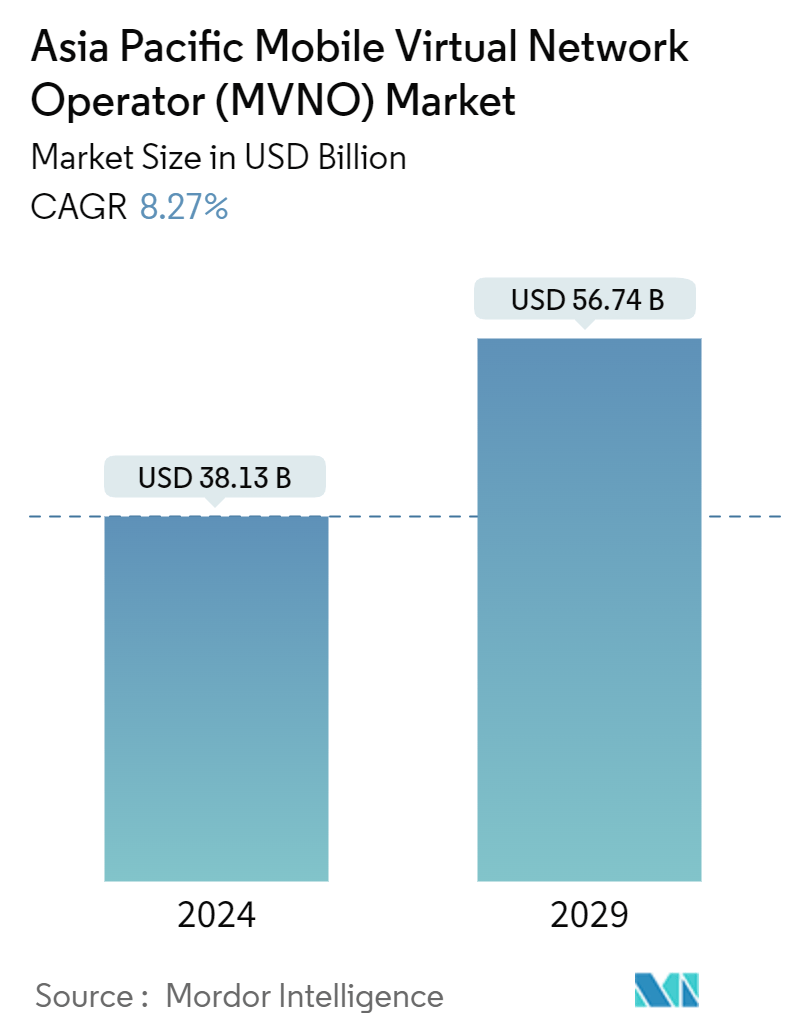Market Size of Asia Pacific Mobile Virtual Network Operator (MVNO) Industry

| Study Period | 2019 - 2029 |
| Base Year For Estimation | 2023 |
| Market Size (2024) | USD 38.13 Billion |
| Market Size (2029) | USD 56.74 Billion |
| CAGR (2024 - 2029) | 8.27 % |
| Market Concentration | Low |
Major Players
*Disclaimer: Major Players sorted in no particular order |
Asia-Pacific MVNOs Market Analysis
The Asia Pacific Mobile Virtual Network Operator Market size is estimated at USD 38.13 billion in 2024, and is expected to reach USD 56.74 billion by 2029, growing at a CAGR of 8.27% during the forecast period (2024-2029).
- The constantly growing need for low-cost data and voice services is boosting market growth. This encourages service providers to purchase network services from mobile network operators (MNOs) at wholesale rates and sell them as bundled services at lower rates than those of MNOs. Such low-cost data services allow mobile virtual network operators (MVNOs) to attract consumers and enterprises in the region to purchase data plans from MVNOs at cost-effective rates.
- The increasing smartphone adoption and mobile subscriber base are expected to contribute significantly to industry growth. For instance, according to the data from GSMA, the number of mobile subscribers in South Asia is anticipated to reach 1,089 million by 2025, followed by 510 million subscribers in Southeast Asia.
- In addition, according to the GSMA forecast, the number of mobile subscribers in Northeast Asia is expected to reach 162 million. Such increasing growth of mobile subscribers presents growth opportunities for mobile virtual network operators to expand their market share in the Asia-Pacific region.
- The Asia-Pacific mobile virtual network operators market faces significant challenges due to its dependency on host mobile network operators. This dependency impacts MVNOs' operational and strategic capabilities, restraining their growth and market potential. MVNOs rely on MNOs for network access, which means they have limited control over the quality of service and network coverage. Any shortcomings in the host network directly affect the MVNO's service quality.
- The COVID-19 pandemic has positively fueled the demand for MVNOs' cost-effective data and voice services during the pandemic due to the increased reliance of consumers and businesses on online connectivity. In addition, the digital transformation among businesses in the region spiked post-pandemic, which has further fueled the demand for data services, thus positively impacting the growth of the MVNO market in the Asia-Pacific region.
- In the post-pandemic era, MVNOs in Asia-Pacific countries are analyzed to innovate and introduce new services to meet consumers' and enterprises' evolving needs. From enhanced data offerings to innovative pricing plans, MVNOs are expected to leverage digital technologies, machine learning, and artificial intelligence to deliver personalized and seamless customer experiences. Such developments are expected to positively support the growth of the Asia-Pacific MVNO market in the coming years.
Asia-Pacific MVNOs Industry Segmentation
The Asia-Pacific MVNO market is defined based on the revenues generated from the MVNO services offered by various players operating in the market. The analysis is based on the market insights captured through secondary research and primaries. The market also covers the major factors impacting its growth in terms of drivers and restraints.
The study tracks the key market parameters, underlying growth influencers, and major vendors operating in the industry, which supports market estimations and growth rates over the forecast period. The study also tracks the revenue accrued from MVNO services offered by various players operating in the market. In addition, the study provides the Asia-Pacific MVNO market trends, along with key vendor profiles.
The Asia-Pacific MVNO market is segmented by operational mode (reseller, service operator, full MVNO, other operational modes), subscriber (enterprise and consumer), and country (Mainland China, Japan, India, South Korea, and the Rest of Asia-Pacific). The market sizes and forecasts are provided in terms of value (USD) for all the above segments.
| By Operational Mode | |
| Reseller | |
| Service Operator | |
| Full MVNO | |
| Other Operational Modes |
| By Subscriber | |
| Enterprise | |
| Consumer |
| By Country*** | |
| China | |
| Japan | |
| India | |
| South Korea |
Asia Pacific Mobile Virtual Network Operator (MVNO) Market Size Summary
The Asia-Pacific MVNO market is experiencing robust growth, driven by the increasing demand for cost-effective data and voice services. This demand is prompting service providers to acquire network services from mobile network operators at wholesale rates, allowing them to offer competitive pricing to consumers and enterprises. The region's expanding smartphone adoption and mobile subscriber base are significant contributors to this growth, presenting ample opportunities for MVNOs to enhance their market share. However, the market faces challenges due to its reliance on host mobile network operators, which can limit MVNOs' control over service quality and network coverage. The COVID-19 pandemic has further accelerated the demand for MVNO services, as businesses and consumers increasingly depend on online connectivity, leading to a surge in digital transformation initiatives across the region.
In the enterprise segment, MVNOs are poised for significant growth, fueled by the rising digital transformation and the rollout of 5G services in Asia-Pacific countries. The enterprise market offers lucrative opportunities, with trends such as flexible billing, security, and easy administration driving demand. Countries like South Korea are leading this growth, supported by favorable regulatory policies and a strong focus on enterprise connectivity solutions. The adoption of eSIM technology and the expansion of 5G networks are enabling MVNOs to offer advanced services, attracting tech-savvy customers. Major players in the market are leveraging partnerships and acquisitions to enhance their offerings and maintain a competitive edge. As industries continue to evolve, MVNOs are expected to capitalize on new opportunities, from mobile banking to IoT, shaping the future of connectivity in the region.
Asia Pacific Mobile Virtual Network Operator (MVNO) Market Size - Table of Contents
-
1. MARKET DYNAMICS
-
1.1 Market Drivers
-
1.1.1 MVNO Penetration and Characteristics Similar to Major European Countries
-
1.1.2 Regulatory Environment in Most Asian Countries Became Much More Supportive of MVNOs
-
1.1.3 Internet Penetration and e-SIM Solutions Driving the MVNO Market in the Region
-
-
1.2 Market Restraints
-
1.2.1 Dependency on Host Mobile Network Operators (MNO)
-
-
-
2. MARKET SEGMENTATION
-
2.1 By Operational Mode
-
2.1.1 Reseller
-
2.1.2 Service Operator
-
2.1.3 Full MVNO
-
2.1.4 Other Operational Modes
-
-
2.2 By Subscriber
-
2.2.1 Enterprise
-
2.2.2 Consumer
-
-
2.3 By Country***
-
2.3.1 China
-
2.3.2 Japan
-
2.3.3 India
-
2.3.4 South Korea
-
-
Asia Pacific Mobile Virtual Network Operator (MVNO) Market Size FAQs
How big is the Asia Pacific Mobile Virtual Network Operator Market?
The Asia Pacific Mobile Virtual Network Operator Market size is expected to reach USD 38.13 billion in 2024 and grow at a CAGR of 8.27% to reach USD 56.74 billion by 2029.
What is the current Asia Pacific Mobile Virtual Network Operator Market size?
In 2024, the Asia Pacific Mobile Virtual Network Operator Market size is expected to reach USD 38.13 billion.

